Effect of Lignosulphonates on the Moisture Resistance of Phenol–Formaldehyde Resins for Exterior Plywood
Abstract
:1. Introduction
2. Materials and Methods
2.1. Materials
2.2. Physico-Chemical Characterization of the LS Samples
2.3. Fourier Transform Infrared Spectroscopy (FTIR)
2.4. Resin Synthesis
2.5. Methylolation
2.6. Resin Characterization
- pH—The pH of the obtained resins was measured at 25 °C using a pH glass electrode with an integrated temperature probe.
- Viscosity (cP)—The viscosity of the resins was measured at a constant temperature of 25 °C using a Brookfield DV-II programmable viscometer.
- Density (g·cm−3)—The determination of the resin’s density is based on the weight/volume ratio and was conducted using a hydrometer.
- Solids content (%)—The solids content was determined by drying 2 g of resin for 2 h in an oven at 135 °C. Three replicates were caried out for each resin.
- Free formaldehyde content (%)—The free formaldehyde content of the obtained resins was not determined. This was due to the rapid precipitation of the resins upon the addition of acid, which is required for the adjustment of a sample’s pH as stated in ISO 11402:2004 [41].
- Water tolerance (%)—For the determination of the water tolerance of the resins, 5 mL of resin was placed inside a test tube and water was added gradually. When the solution turned turbid, the consumed water volume was registered and the water tolerance was determined as follows:where is the volume, in mL, of water added.
- Shelf-life (days)—The increase in viscosity of the resins over the course of several days at 25 °C was measured using a Brookfield DV-II programmable viscometer. The shelf-life of the resins was established as the number of days required for a viscosity above 700 cP to be reached.
- Automated Bonding Evaluation System (ABES)—The bonding performance to a wood substrate of the manufactured resins was evaluated by testing the samples in shear mode. For this test, two wood veneer strips (Fagus sylvatica), 0.5 mm thick, 20 mm wide, and 117 mm in length, were used. These strips were previously stored at a controlled temperature (25 °C) and relative humidity (65%) in order to stabilize them and achieve an equilibrium moisture content between 8 and 11% (dry basis). These wood test pieces were glued manually together with a spatula (10 mg in 100 mm2) with the resin formulation (composed of the resin, wheat flour, and calcium carbonate). After the set temperature was reached, the strips were mounted in the system with an overlapping area of 20 × 5 mm2 and pressed together at 1.2 N·mm−2 for a chosen period of time. The system is digitally controlled and pneumatically driven, and a standard loading rate of 1 kN·s−1 was used [42].
2.7. Plywood Production
2.8. Plywood Characterization
3. Results and Discussion
3.1. Characterization of LS Samples
3.2. Shelf-Life and ABES Performance of Hardwood Lignosulphonates (HLS)
3.3. Shelf-Life and ABES Performance of Softwood Lignosulphonates (SLS)
3.4. Plywood Bonding Performance—HLS vs. SLS
3.5. Plywood Bonding Performance—Effect of Phenol Substitution Amount
4. Conclusions
Author Contributions
Funding
Data Availability Statement
Conflicts of Interest
References
- Hughes, M. Plywood and Other Veneer-Based Products. In Wood Composites; Ansell, M.P., Ed.; Elsevier: Amsterdam, The Netherlands, 2015; pp. 69–89. [Google Scholar]
- Kollmann, F.F.P.; Kuenzi, E.W.; Stamm, A.J. Principles of Wood Science and Technology; Springer: Berlin/Heidelberg, Germany, 1975; Volume 2, ISBN 978-3-642-87933-3. [Google Scholar]
- Global Market Insights. Plywood Market Report, 2032. 2023. Available online: https://www.gminsights.com/industry-analysis/plywood-market (accessed on 5 July 2024).
- Gardziella, A.; Pilato, L.A.; Knop, A. Phenolic Resins: Chemistry, Applications, Standardization, Safety and Ecology; Springer: Berlin/Heidelberg, Germany, 2000; pp. 24–82. ISBN 978-3-642-08484-3. [Google Scholar]
- EN 313-1:1996; Plywood—Classification and Terminology—Part 1: Classification. European Committee for Standardization: Brussels, Belgium, 1996.
- Irle, M.; Barbu, M.C. Wood-Based Panel Technology. In Wood-Based Panels—An Introduction for Specialists; Thoemen, H., Irle, M., Sernek, M., Eds.; Brunel University Press: London, UK, 2010; pp. 1–94. [Google Scholar]
- Pilato, L. Phenolic Resins: A Century of Progress; Springer: Berlin, Germany, 2010. [Google Scholar]
- Bekhta, P.; Hiziroglu, S.; Shepelyuk, O. Properties of Plywood Manufactured from Compressed Veneer as Building Material. Mater. Des. 2009, 30, 947–953. [Google Scholar] [CrossRef]
- Pizzi, A. Phenolic Resin Wood Adhesives. In Advanced Wood Adhesives Technology; Marcel Dekker: New York, NY, USA, 1994; pp. 89–147. [Google Scholar]
- Pizzi, A. Phenolic Resin Adhesives. In Handbook of Adhesive Technology, 3rd ed.; Pizzi, A., Mittal, K.L., Eds.; CRC Press: Boca Raton, FL, USA, 2018; pp. 224–261. [Google Scholar]
- Pizzi, A. Phenolic Resin Adhesives. In Handbook of Adhesive Technology; Pizzi, A., Mittal, K.L., Eds.; Marcel Dekker: New York, NY, USA, 2003. [Google Scholar]
- Li, C.; Zhao, X.; Wang, A.; Huber, G.W.; Zhang, T. Catalytic Transformation of Lignin for the Production of Chemicals and Fuels. Chem. Rev. 2015, 115, 11559–11624. [Google Scholar] [CrossRef]
- Aro, T.; Fatehi, P. Production and Application of Lignosulfonates and Sulfonated Lignin. ChemSusChem 2017, 10, 1861–1877. [Google Scholar] [CrossRef]
- Lora, J. Industrial Commercial Lignins: Sources, Properties and Applications. In Monomers, Polymers and Composites from Renewable Resources; Belgacem, M.N., Gandini, A., Eds.; Elsevier: Amsterdam, The Netherlands, 2008; pp. 225–241. [Google Scholar]
- Hemmilä, V.; Trischler, J.; Sandberg, D. Lignin: An Adhesive Raw Material of the Future or Waste of Research Energy? In Northern European Network for Wood Science and Engineering (WSE), Proceedings of the 9th Meeting, 11–12 September 2013, Hannover, Germany; Brischke, C., Meyer, L., Eds.; Leibniz Universität: Hannover, Germany, 2013; pp. 98–103. Available online: https://www.diva-portal.org/smash/get/diva2:1004499/FULLTEXT01.pdf (accessed on 26 July 2024).
- Maximize Market Research. Lignin Market: Industry Forecast (2024–2030) by Raw Material, Product, Application, and Region. 2023. Available online: https://www.maximizemarketresearch.com/market-report/lignin-market/13321/ (accessed on 15 May 2024).
- Hemmilä, V.; Adamopoulos, S.; Karlsson, O.; Kumar, A. Development of Sustainable Bio-Adhesives for Engineered Wood Panels—A Review. RSC Adv. 2017, 7, 38604–38630. [Google Scholar] [CrossRef]
- El Mansouri, N.; Pizzi, A.; Salvadó, J. Lignin-Based Wood Panel Adhesives without Formaldehyde. Holz Als Roh-Und Werkst. 2007, 65, 65–70. [Google Scholar] [CrossRef]
- Younesi-Kordkheili, H.; Pizzi, A. A Comparison between Lignin Modified by Ionic Liquids and Glyoxalated Lignin as Modifiers of Urea-Formaldehyde Resin. J. Adhes. 2017, 93, 1120–1130. [Google Scholar] [CrossRef]
- Alonso, M.V.; Oliet, M.; Rodríguez, F.; García, J.; Gilarranz, M.A.; Rodríguez, J.J. Modification of Ammonium Lignosulfonate by Phenolation for Use in Phenolic Resins. Bioresour. Technol. 2005, 96, 1013–1018. [Google Scholar] [CrossRef] [PubMed]
- Hu, L.; Pan, H.; Zhou, Y.; Zhang, M. Methods to Improve Lignin’s Reactivity as a Phenol Substitute and as Replacement for Other Phenolic Compounds: A Brief Review. Bioresources 2011, 6, 3515–3525. [Google Scholar] [CrossRef]
- Londoño Zuluaga, C.; Du, J.; Chang, H.-M.; Jameel, H.; Gonzalez, R.W. Lignin Modifications and Perspectives towards Applications of Phenolic Foams: A Review. Bioresources 2018, 13, 9158–9179. [Google Scholar] [CrossRef]
- Younesi-Kordkheili, H.; Pizzi, A.; Honarbakhsh-Raouf, A.; Nemati, F. The Effect of Soda Bagasse Lignin Modified by Ionic Liquids on Properties of the Urea–Formaldehyde Resin as a Wood Adhesive. J. Adhes. 2017, 93, 914–925. [Google Scholar] [CrossRef]
- El Mansouri, N.-E.; Farriol, X.; Salvadó, J. Structural Modification and Characterization of Lignosulfonate by a Reaction in an Alkaline Medium for Its Incorporation into Phenolic Resins. J. Appl. Polym. Sci. 2006, 102, 3286–3292. [Google Scholar] [CrossRef]
- Ghorbani, M.; Konnerth, J.; van Herwijnen, H.W.G.; Zinovyev, G.; Budjav, E.; Requejo Silva, A.; Liebner, F. Commercial Lignosulfonates from Different Sulfite Processes as Partial Phenol Replacement in PF Resole Resins. J. Appl. Polym. Sci. 2018, 135, 45893. [Google Scholar] [CrossRef]
- Antov, P.; Mantanis, G.I.; Savov, V. Development of Wood Composites from Recycled Fibres Bonded with Magnesium Lignosulfonate. Forests 2020, 11, 613. [Google Scholar] [CrossRef]
- Mansouri, N.-E.E.; Salvadó, J. Structural Characterization of Technical Lignins for the Production of Adhesives: Application to Lignosulfonate, Kraft, Soda-Anthraquinone, Organosolv and Ethanol Process Lignins. Ind. Crops. Prod. 2006, 24, 8–16. [Google Scholar] [CrossRef]
- Alonso, M.V.; Oliet, M.; Rodríguez, F.; Astarloa, G.; Echeverría, J.M. Use of a Methylolated Softwood Ammonium Lignosulfonate as Partial Substitute of Phenol in Resol Resins Manufacture. J. Appl. Polym. Sci. 2004, 94, 643–650. [Google Scholar] [CrossRef]
- Akhtar, T.; Lutfullah, G.; Nazli, R. Synthesis of Lignin Based Phenolic Resin and Its Utilization in the Exterior Grade Plywood. J. Chem. Soc. Pak. 2009, 31, 304–308. [Google Scholar]
- NP EN 314-1:2002; Plywood—Bonding Quality—Part 1: Test Methods. Instituto Português da Qualidade: Caparica, Portugal, 2002.
- Ghorbani, M.; Liebner, F.; van Herwijnen, H.W.G.; Solt, P.; Konnerth, J. Ligneous Resole Adhesives for Exterior-Grade Plywood. Eur. J. Wood Wood Prod. 2018, 76, 251–258. [Google Scholar] [CrossRef]
- NP EN 314-2:2002; Plywood—Bonding Quality—Part 2: Requirements. Instituto Português da Qualidade: Caparica, Portugal, 2002.
- Kalami, S.; Arefmanesh, M.; Master, E.; Nejad, M. Replacing 100% of Phenol in Phenolic Adhesive Formulations with Lignin. J. Appl. Polym. Sci. 2017, 134, 45124. [Google Scholar] [CrossRef]
- Pietarinen, S.; Valkonen, S.; Ringena, O. Method of Making a Binder Composition, and Binder Composition. U.S. Patent Application No. 18/216,422, 29 June 2023. [Google Scholar]
- UPM. Biochemicals Lignin-Phenol-Formaldehyde Resin in Plywood. Available online: https://www.upmbiochemicals.com/siteassets/documents/lignin/lignin-phenol-formaldehyde_resin_in_plywood.pdf (accessed on 7 May 2024).
- Marques, A.P. Caracterização e Transformação de Lenhosulfonatos de Eucalyptus Globulus. Ph.D. Thesis, Universidade de Aveiro, Aveiro, Portugal, 2011. [Google Scholar]
- ISO 1762; Paper, Board, Pulps and Cellulose Nanomaterials—Determination of Residue (Ash Content) on Ignition at 525 °C. ISO: Geneva, Switzerland, 2019.
- Lin, S.Y. Ultraviolet Spectrophotometry. In Methods in Lignin Chemistry; Lin, S.Y., Dence, C.W., Eds.; Springer: Berlin, Germany, 1992. [Google Scholar]
- Alonso, M.V.; Rodríguez, J.J.; Oliet, M.; Rodríguez, F.; García, J.; Gilarranz, M.A. Characterization and Structural Modification of Ammonic Lignosulfonate by Methylolation. J. Appl. Polym. Sci. 2001, 82, 2661–2668. [Google Scholar] [CrossRef]
- Marques, A.P.; Evtuguin, D.V.; Magina, S.; Amado, F.M.L.; Prates, A. Chemical Composition of Spent Liquors from Acidic Magnesium–Based Sulphite Pulping of Eucalyptus Globulus. J. Wood Chem. Technol. 2009, 29, 322–336. [Google Scholar] [CrossRef]
- ISO 11402; Phenolic, Amino and Condensation Resins—Determination of Free-Formaldehyde Content. ISO: Geneva, Switzerland, 2004.
- ASTM D7998-19; Standard Test Method for Measuring the Effect of Temperature on the Cohesive Strength Development of Adhesives Using Lap Shear Bonds under Tensile Loading. ASTM International: West Conshohocken, PA, USA, 2019.
- NP EN 323:2002; Wood-Based Panels—Determination of Density. Instituto Português da Qualidade: Caparica, Portugal, 2002.
- NP EN 322:2002; Wood-Based Panels—Determination of Moisture Content. Instituto Português da Qualidade: Caparica, Portugal, 2002.
- NP EN 310:2002; Wood-Based Panels—Determination of Modulus of Elasticity in Bending and of Bending Strength. Instituto Português da Qualidade: Caparica, Portugal, 2002.
- NP EN ISO 12460-3:2018; Wood-Based Panels Determination of Formaldehyde Release Part 3: Gas Analysis Method (ISO 12460-3:2015). Instituto Português da Qualidade: Caparica, Portugal, 2018.
- Magina, S.P. New Polymeric Formulations Based on Lignosulphonates. Ph.D. Thesis, University of Aveiro, Aveiro, Portugal, 2021. [Google Scholar]
- Resende, M. Desenvolvimento de Uma Resina Fenol-Formaldeído Para Impregnação de Papel Kraft Para Produção de Laminados de Alta Pressão. Master’s Thesis, Faculdade de Engenharia da Universidade do Porto, Porto, Portugal, 2018. [Google Scholar]
- Marques, A.P.; Evtuguin, D.V.; Magina, S.; Amado, F.M.L.; Prates, A. Structure of Lignosulphonates from Acidic Magnesium-Based Sulphite Pulping of Eucalyptus Globulus. J. Wood Chem. Technol. 2009, 29, 337–357. [Google Scholar] [CrossRef]
- Faix, O. Fourier Transform Infrared Spectroscopy. In Methods in Lignin Chemistry; Lin, S.Y., Dence, C.W., Eds.; Springer: Berlin, Germany, 1992. [Google Scholar]
- Hemmilä, V.; Hosseinpourpia, R.; Adamopoulos, S.; Eceiza, A. Characterization of Wood-Based Industrial Biorefinery Lignosulfonates and Supercritical Water Hydrolysis Lignin. Waste Biomass Valorization 2020, 11, 5835–5845. [Google Scholar] [CrossRef]
- Bellamy, L.J. The Infrared Spectra of Complex Molecules—Advances in Infrared Group Frequencies, 2nd ed.; Springer: Berlin/Heidelberg, Germany, 1980; Volume 2. [Google Scholar]
- Gellerstedt, G.; Henriksson, G. Lignins: Major Sources, Structure and Properties. In Monomers, Polymers and Composites from Renewable Resources; Elsevier: Amsterdam, The Netherlands, 2008. [Google Scholar]
- Gonçalves, S.; Martins, J.; Paiva, N.T.; Paiva, D.; Carvalho, L.H.; Magalhães, F.D. The Potential of Visible Spectroscopy as a Tool for the In-Line Monitoring of Lignin Methylolation. Polymers 2022, 15, 178. [Google Scholar] [CrossRef] [PubMed]
- Zhang, Y.; Li, N.; Chen, Z.; Ding, C.; Zheng, Q.; Xu, J.; Meng, Q. Synthesis of High-Water-Resistance Lignin-Phenol Resin Adhesive with Furfural as a Crosslinking Agent. Polymers 2020, 12, 2805. [Google Scholar] [CrossRef]
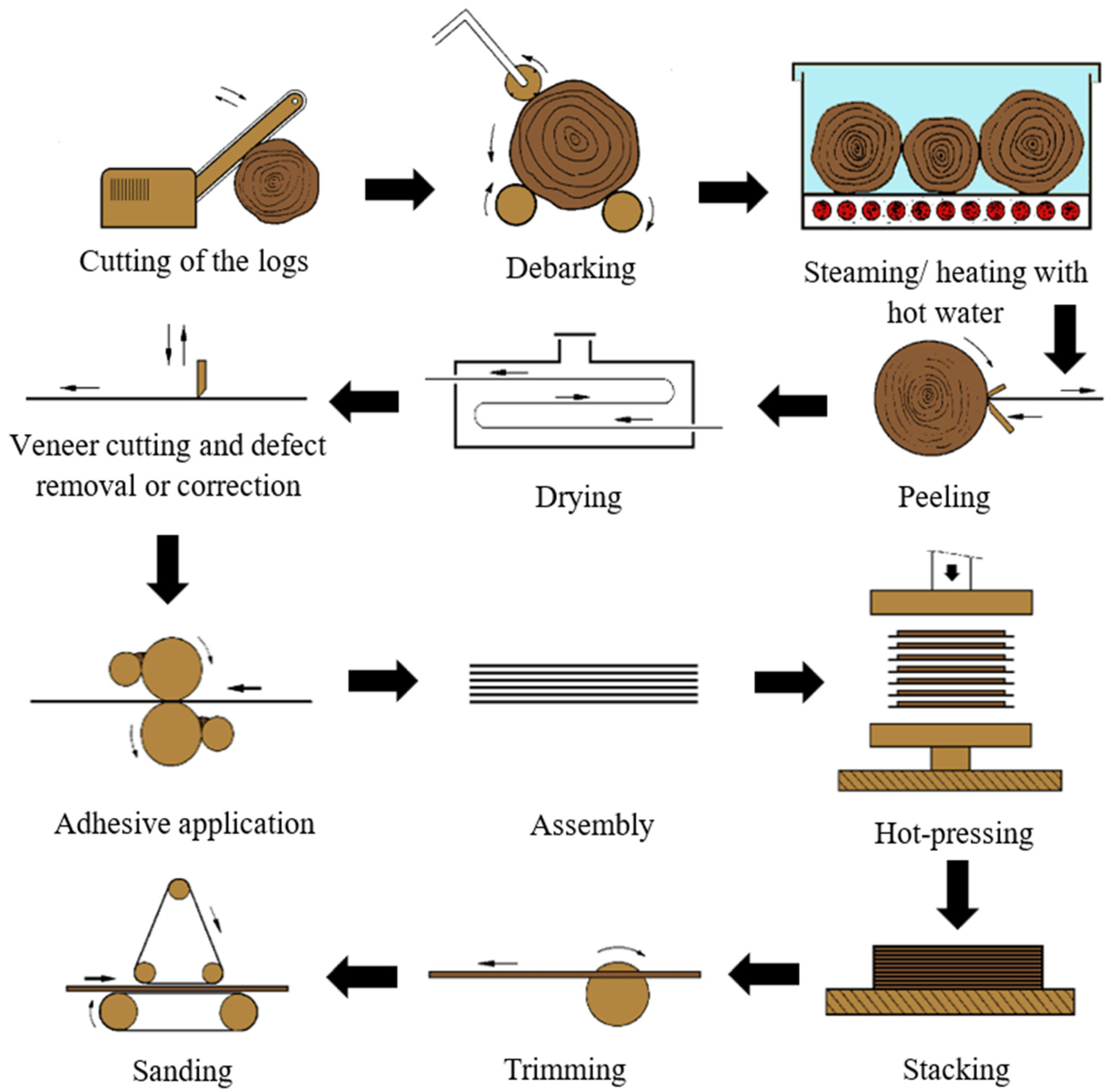
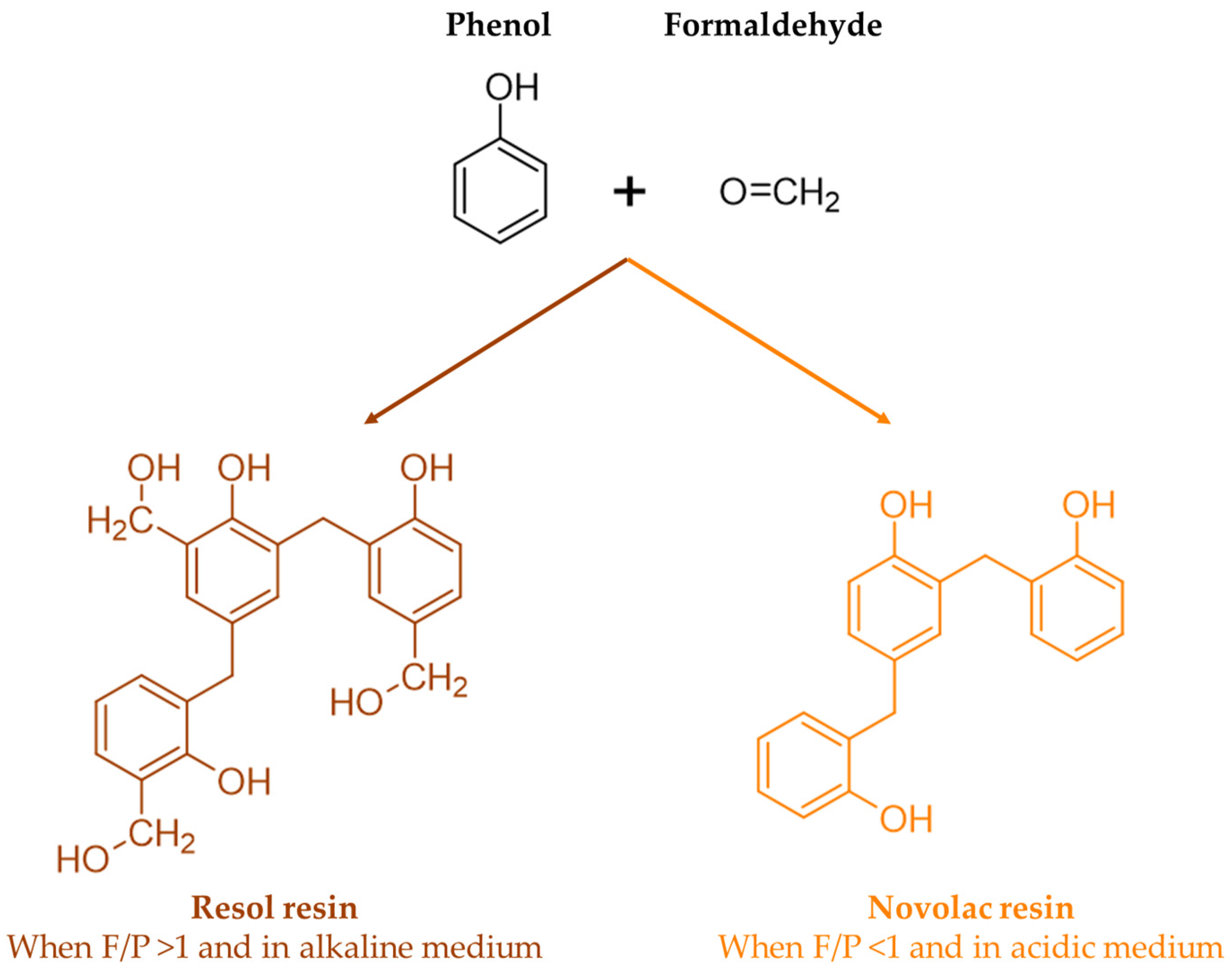

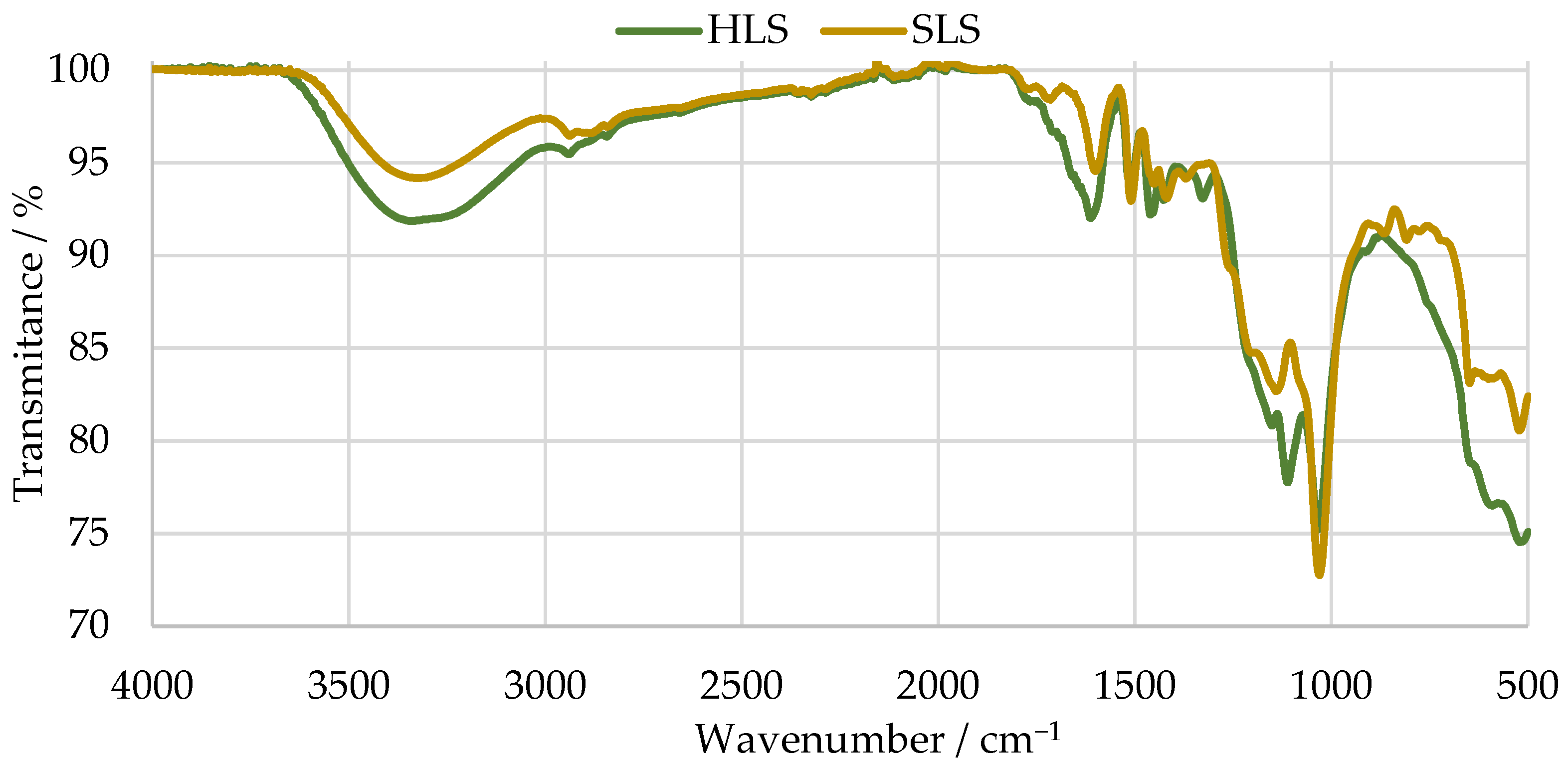
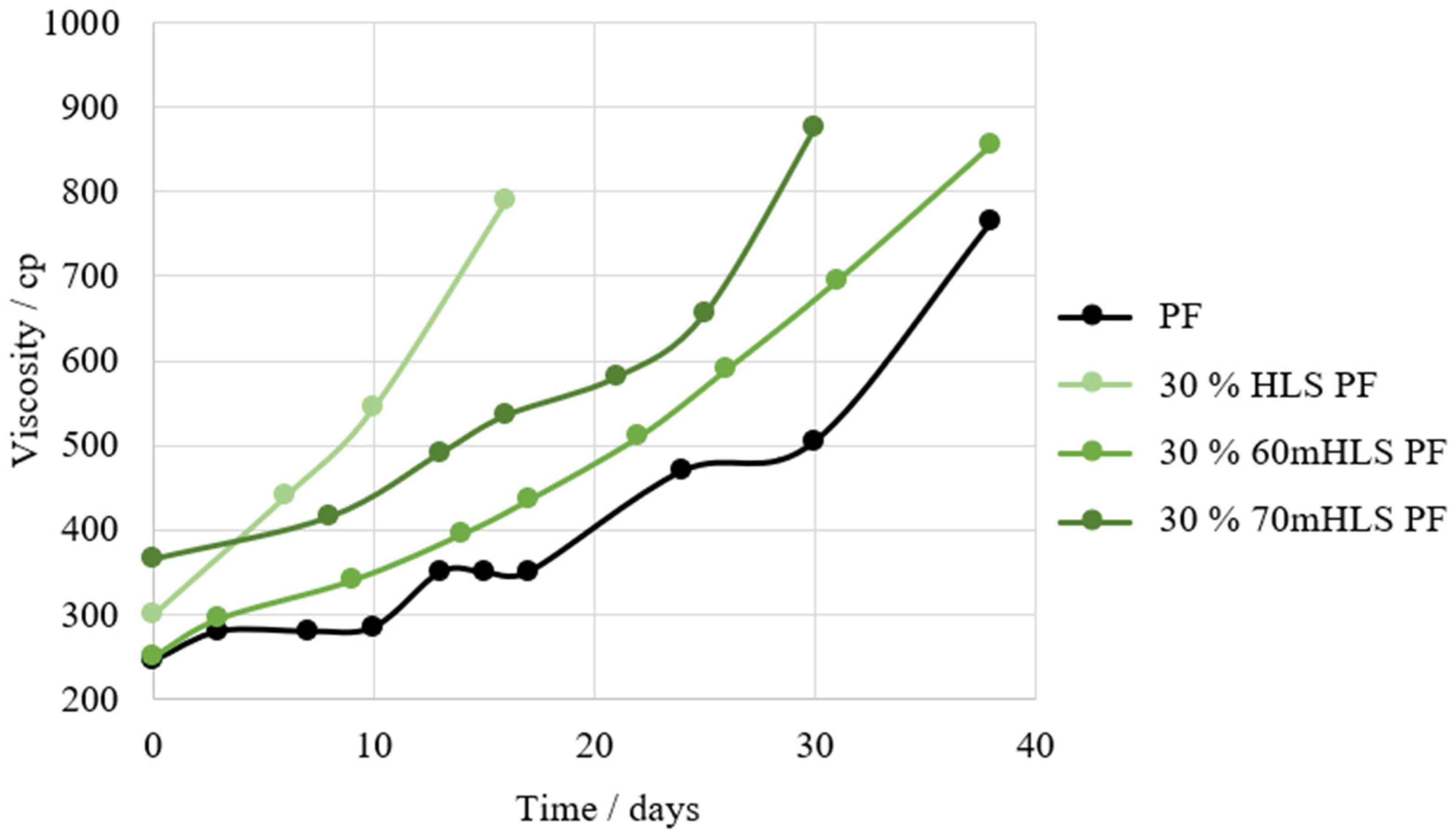


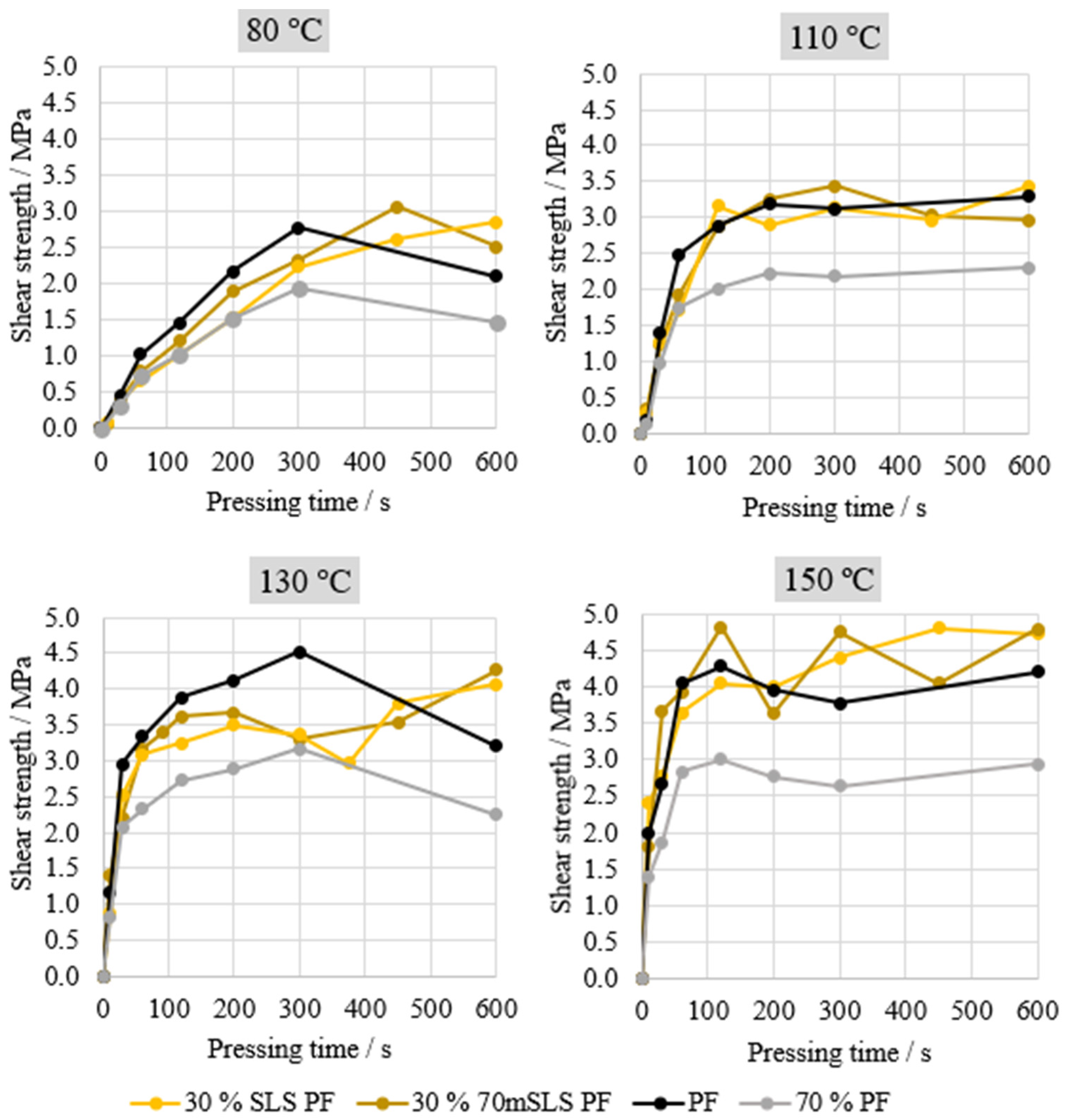
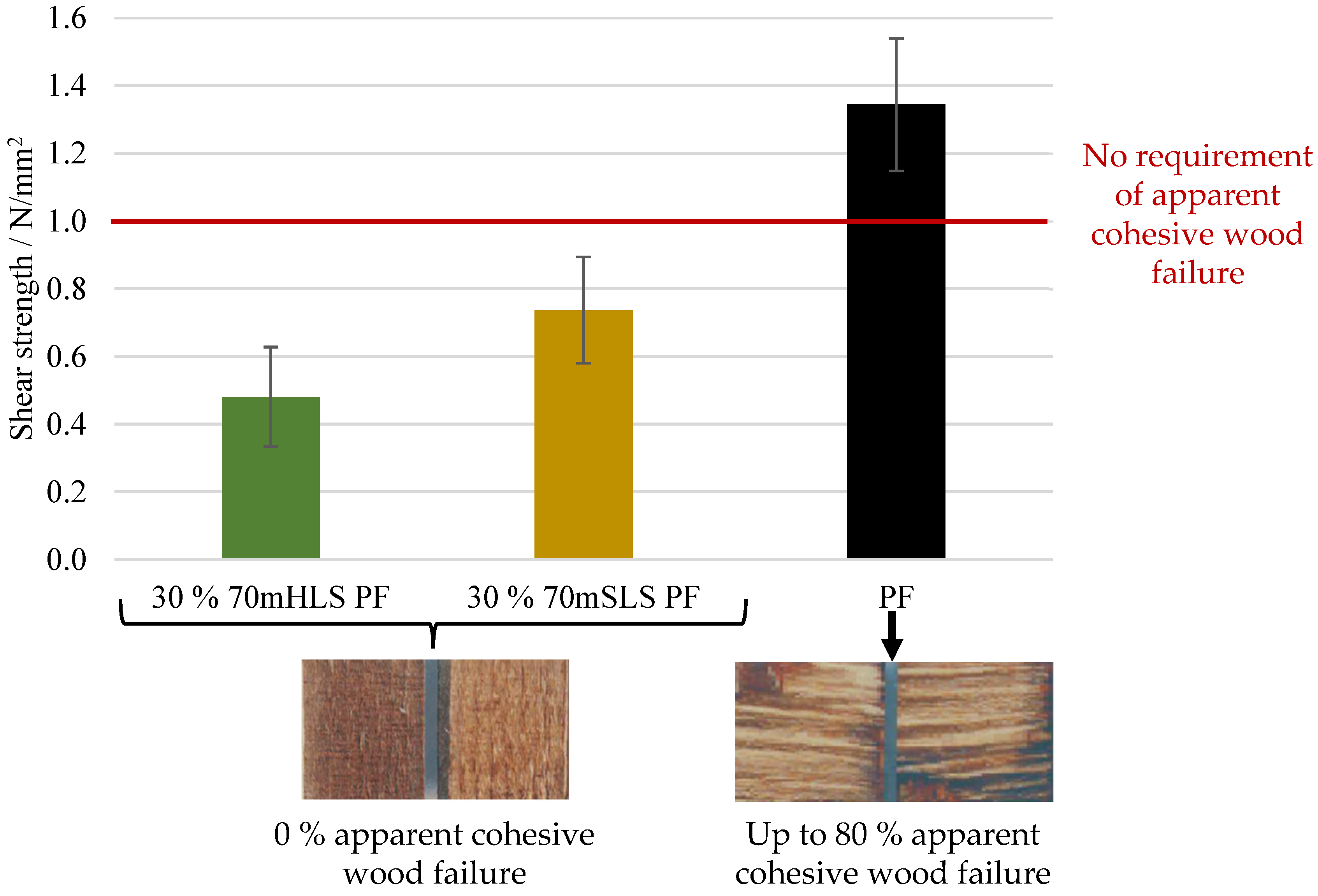
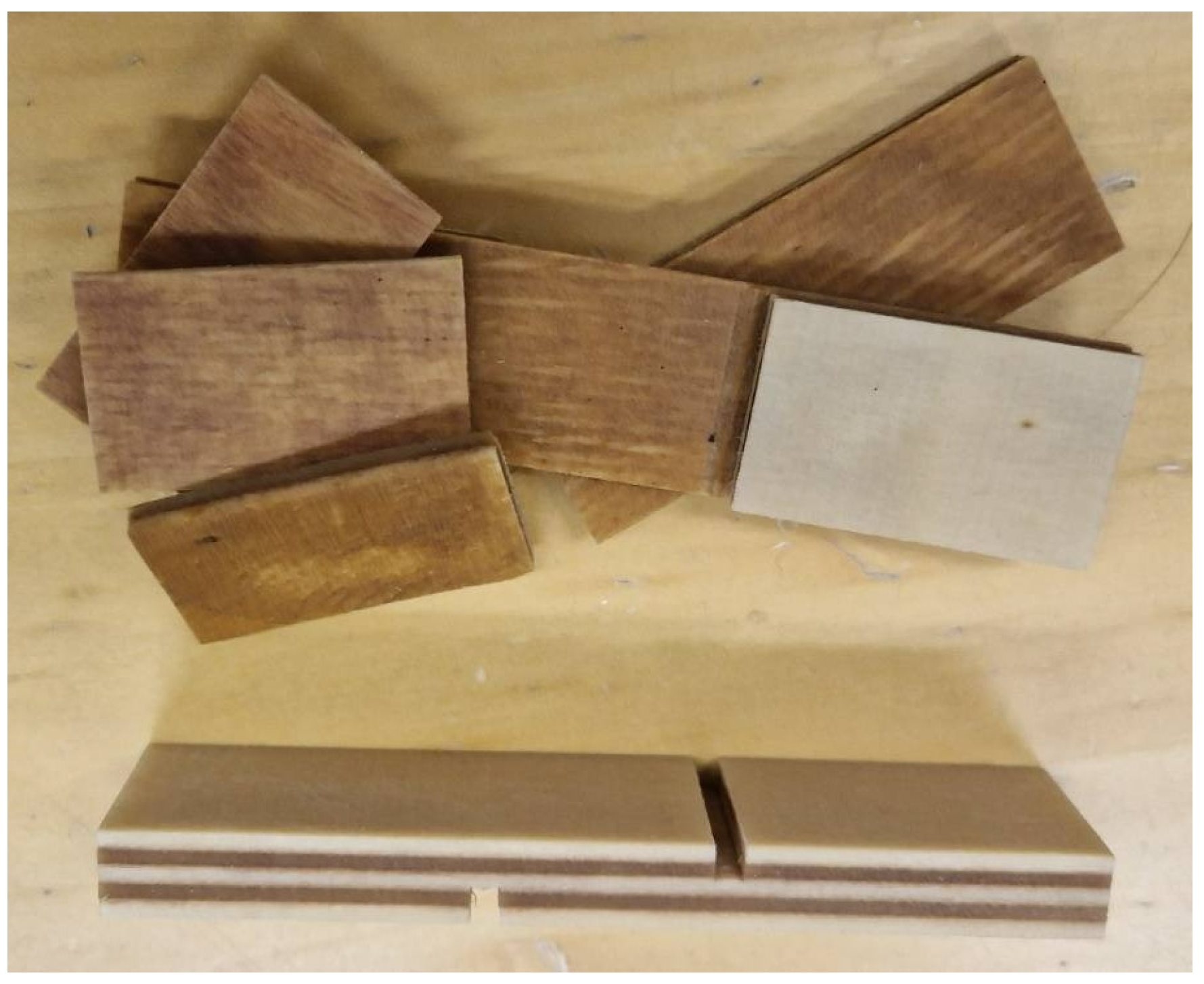
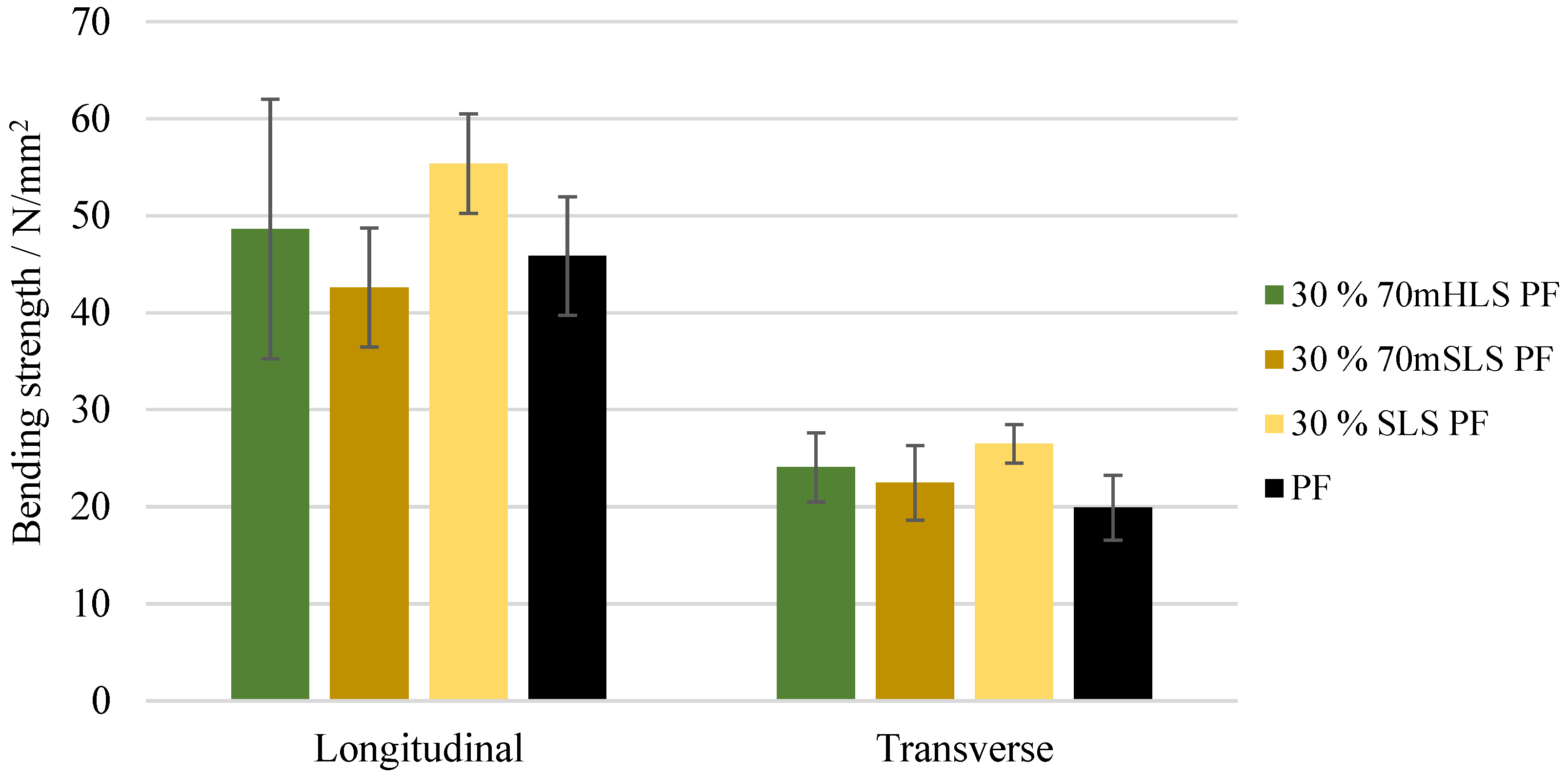
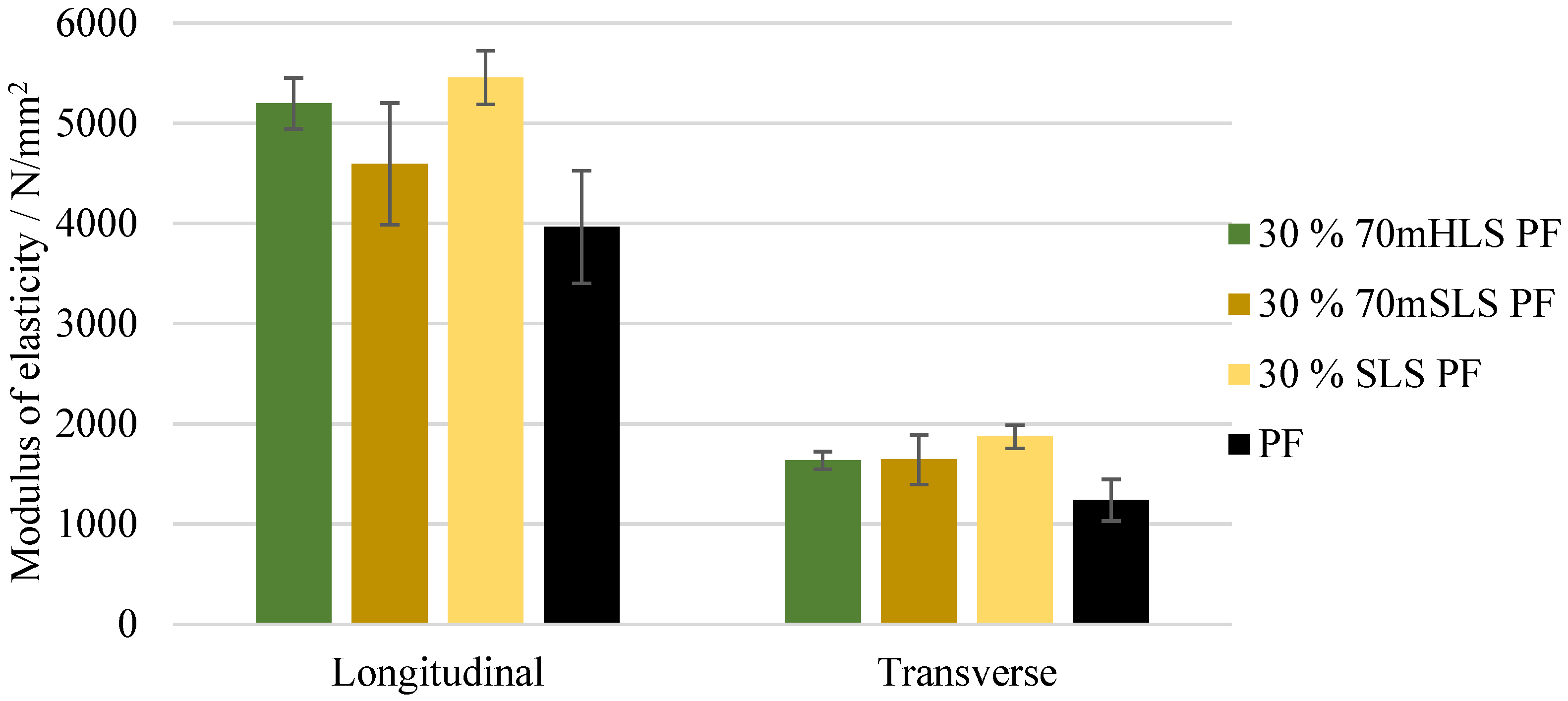

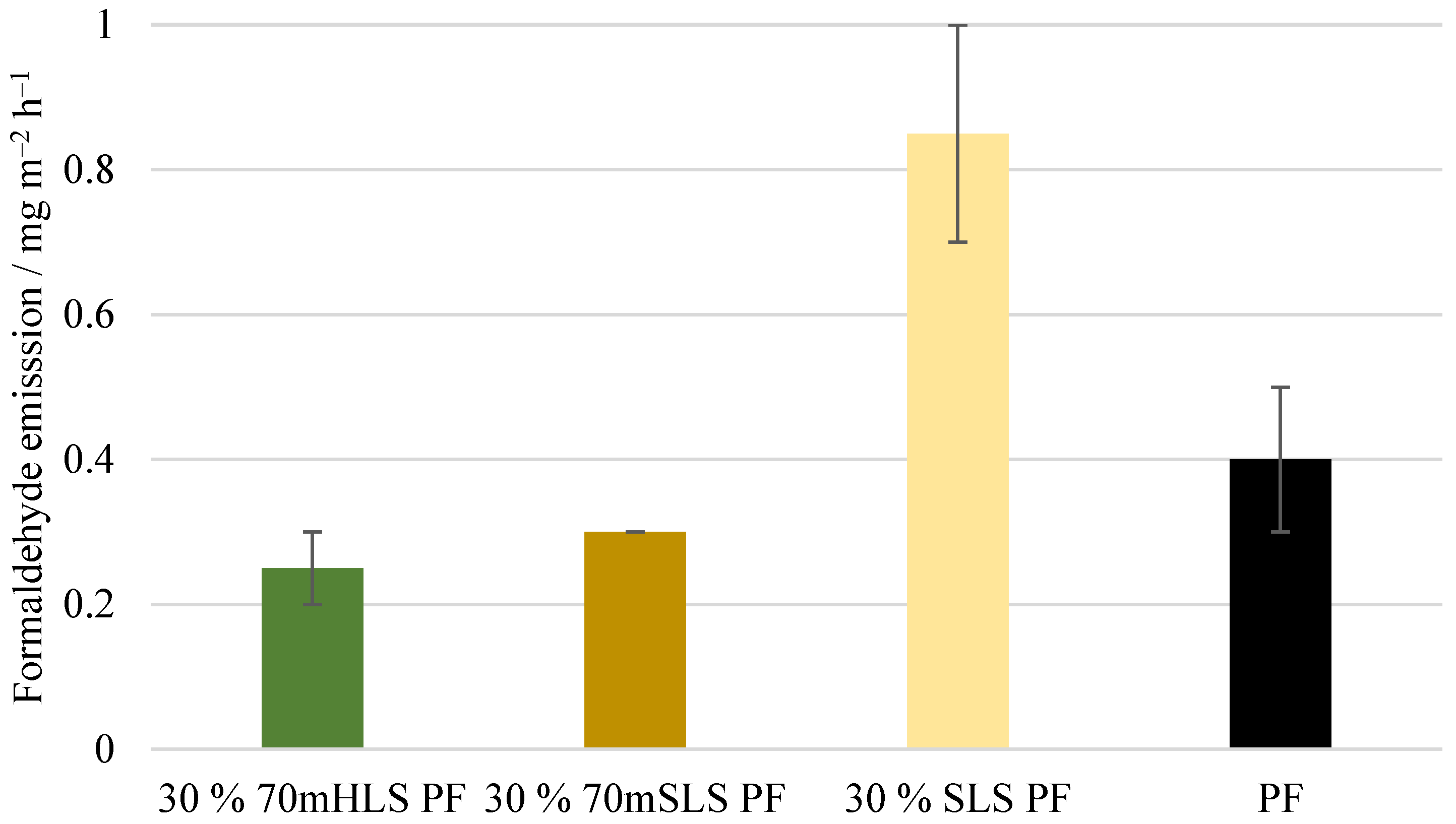
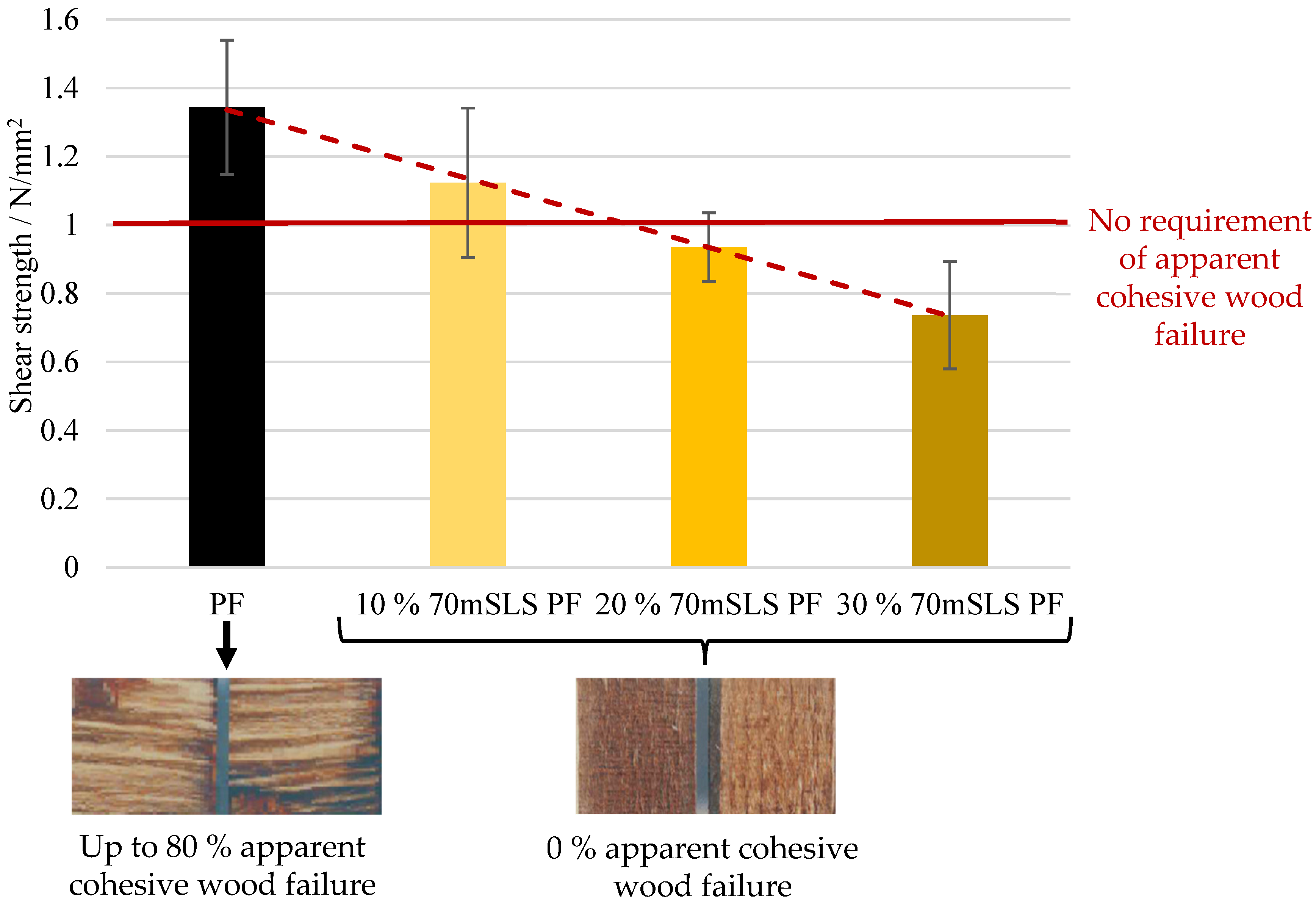



| Shear Strength fv (N/mm2) | Average Apparent Cohesive Wood Failure (%) |
|---|---|
| 0.2 ≤ fv < 0.4 | ≥80 |
| 0.4 ≤ fv < 0.6 | ≥60 |
| 0.6 ≤ fv < 1.0 | ≥40 |
| 1.0 ≤ fv | No requirements |
| Parameter | SLS | HLS |
|---|---|---|
| Density/g/cm3 | - | 1.308 |
| Viscosity/cP | - | 32 |
| pH | - | 2.48 |
| Dry matter/% | 96.0 | 54.7 |
| LS content/% | 80.8 | 33.5 |
| Carbohydrate content/% | <6 b | 12.6 c |
| LS content/% a | 84.2 | 61.2 |
| Ash content/% a | 22.6 | 12.2 |
| Wavenumber (cm−1) | Band Origin and Comments | SLS | HLS |
|---|---|---|---|
| 3420–3250 | O-H stretch (phenolic and aliphatic OH) | 3332 | 3332 |
| 3000–2842 | C-H stretch in methyl and methylene groups | 2938 | 2940 |
| 2850–2840 | C-H stretching (OCH3) | 2843 | 2844 |
| 2000–1650 | Several bands from overtones and combinations (substituted benzene rings) | 1769 | 1766 |
| 1738–1709 | C=O stretch in unconjugated ketones, carbonyls, and in ester groups (frequently of carbohydrate origin) | 1714 | 1704 |
| 1605–1593 | Aromatic skeletal vibrations; C=O stretch | 1601 | 1613 |
| 1515–1505 | Aromatic skeletal vibrations | 1510 | 1515 |
| 1470–1460 | C-H deformations (asymmetric in CH3 and CH2) | 1452 | 1461 |
| 1430–1422 | Aromatic skeletal vibrations and C-H in-plane deformation | 1418 | 1426 |
| 1370–1365 | Aliphatic C-H stretch in CH3, not in OCH3; phenolic OH | 1370 | 1367 |
| 1330–1325 | S ring and G ring substituted in C5 | - | 1328 |
| 1270–1266 | G ring; C=O stretch | 1261 | - |
| 1260–1150 | Sulphonic acids | 1205 | 1209 |
| 1166 | C=O in conjugated ester groups | - | 1151 |
| 1140 | Aromatic C-H in-plane deformation; typical for G units | 1140 | - |
| 1128–1125 | Aromatic C-H in-plane deformation (S units); secondary alcohols; C=O stretch | - | 1111 |
| 1080–1010 | Characteristic LS peak at 1037 cm−1; sulfonic acids; deformation of aromatic C-H and C-O in primary alcohols; C=O stretch unconjugated | 1030 | 1034 |
| 858–853 | C-H out-of-plane in positions 2, 5, and 6 of G units | 865 | - |
| 832–817 | C-H out-of-plane in positions 2, 5, and 6 of G units | 809 | - |
| 700–600 | Sulphonic acids | 648 | 644 |
| PF | 30% HLS PF | 30% 60mHLS PF | 30% 70mHLS PF | |
|---|---|---|---|---|
| pH | 12.4 | 11.9 | 12.1 | 12.4 |
| Viscosity (cP) | 245 | 300 | 250 | 365 |
| Solids content (%) | 42.16 ± 0.23 | 43.01 ± 0.07 | 44.57 ± 0.10 | 43.36 ± 0.12 |
| Density (g/cm3) | 1.192 | 1.209 | 1.221 | 1.222 |
| Water tolerance (%) | >2000 | |||
| PF | 30% 70mHLS PF | 30% SLS PF | 30% 70mSLS PF | |
|---|---|---|---|---|
| pH | 12.4 | 12.4 | 12.1 | 12.1 |
| Viscosity (cP) | 245 | 365 | 270 | 285 |
| Solids content (%) | 42.16 ± 0.23 | 43.36 ± 0.12 | 44.46 ± 0.05 | 44.53 ± 0.05 |
| Density (g/cm3) | 1.192 | 1.222 | 1.217 | 1.218 |
| Water tolerance (%) | >2000 | |||
| PF | 10% 70mSLS PF | 20% 70mSLS PF | 30% 70mSLS PF | |
| pH | 12.4 | 12.2 | 12.3 | 12.1 |
| Viscosity (cP) | 245 | 265 | 285 | 285 |
| Solids content (%) | 42.16 ± 0.23 | 42.06 ± 0.09 | 42.32 ± 0.17 | 44.53 ± 0.05 |
| Density (g/cm3) | 1.192 | 1.192 | 1.201 | 1.218 |
| Water tolerance (%) | >2000 | |||
Disclaimer/Publisher’s Note: The statements, opinions and data contained in all publications are solely those of the individual author(s) and contributor(s) and not of MDPI and/or the editor(s). MDPI and/or the editor(s) disclaim responsibility for any injury to people or property resulting from any ideas, methods, instructions or products referred to in the content. |
© 2024 by the authors. Licensee MDPI, Basel, Switzerland. This article is an open access article distributed under the terms and conditions of the Creative Commons Attribution (CC BY) license (https://creativecommons.org/licenses/by/4.0/).
Share and Cite
Gonçalves, S.; Paiva, N.T.; Martins, J.; Magalhães, F.D.; Carvalho, L.H. Effect of Lignosulphonates on the Moisture Resistance of Phenol–Formaldehyde Resins for Exterior Plywood. Materials 2024, 17, 3715. https://doi.org/10.3390/ma17153715
Gonçalves S, Paiva NT, Martins J, Magalhães FD, Carvalho LH. Effect of Lignosulphonates on the Moisture Resistance of Phenol–Formaldehyde Resins for Exterior Plywood. Materials. 2024; 17(15):3715. https://doi.org/10.3390/ma17153715
Chicago/Turabian StyleGonçalves, Sofia, Nádia T. Paiva, Jorge Martins, Fernão D. Magalhães, and Luísa H. Carvalho. 2024. "Effect of Lignosulphonates on the Moisture Resistance of Phenol–Formaldehyde Resins for Exterior Plywood" Materials 17, no. 15: 3715. https://doi.org/10.3390/ma17153715
APA StyleGonçalves, S., Paiva, N. T., Martins, J., Magalhães, F. D., & Carvalho, L. H. (2024). Effect of Lignosulphonates on the Moisture Resistance of Phenol–Formaldehyde Resins for Exterior Plywood. Materials, 17(15), 3715. https://doi.org/10.3390/ma17153715








